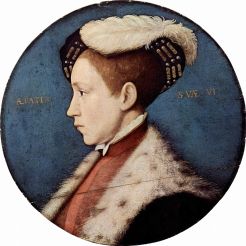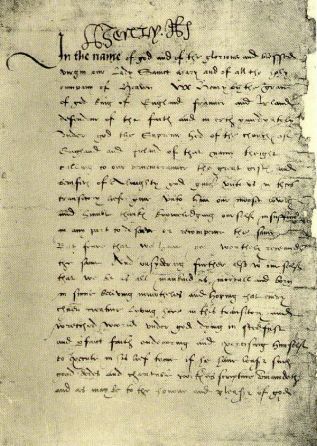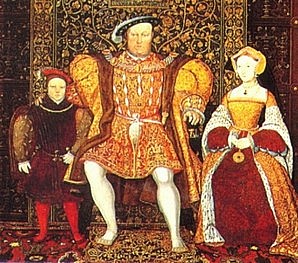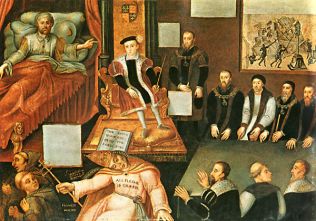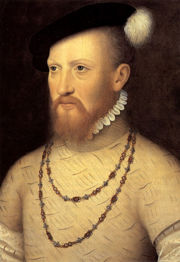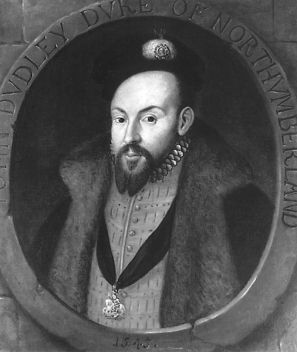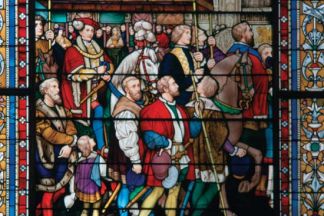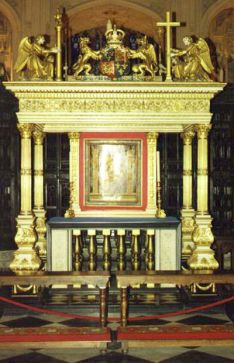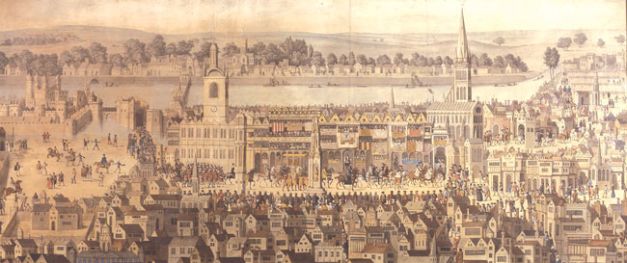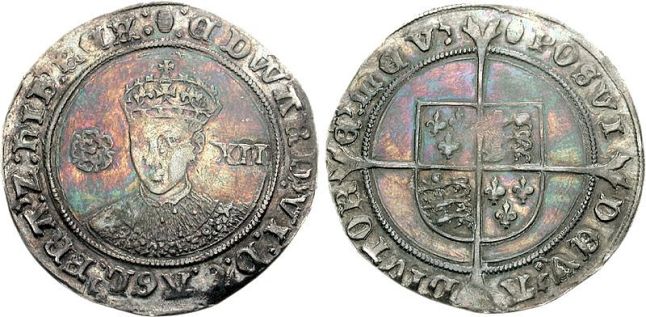INTERESTING FACTS:
- As heir to the throne, His Majestys most noble jewel was brought up with every precaution to ensure his good health. Recent research reveals him as a normally strong and healthy boy fond of athletic exercises such as hunting and hawking.
- Edward was very fond of his Stepmother, Catherine Parr. He called her his "most dear mother" and in September 1546 wrote to her: "I received so many benefits from you that my mind can hardly grasp them".
- He was lavishly provided with toys and comforts, including his own troupe of minstrels, as a contented child.
- Other children were brought to play with Edward and shared his formal education with sons of nobles, "appointed to attend upon him" in what was a form of miniature court. Edward was more devoted to his schoolwork than were his classmates and seems to have outshone them, motivated to do his "duty" and compete with his sister Elizabeth's academic prowess, though his tutor Cox felt it necessary to beat him on at least one occasion
- Both Edward's sisters were attentive to their brother and often visited him—on one occasion, Princess Elizabeth gave him a shirt "of her own working".Edward "took special content" in Princess Mary's company, though he disapproved of her taste for foreign dances; "I love you most", he wrote to her in 1546
- He was knighted by Edward Seymour, Lord Hertford on 17th February 1547
- During Edward's reign, the Church of England became more explicitly Protestant - Edward himself was fiercely so. The Book of Common Prayer was introduced in 1549, aspects of Roman Catholic practices (including statues and stained glass) were eradicated and the marriage of clergy allowed. The imposition of the Prayer Book (which replaced Latin services with English) led to rebellions in Cornwall and Devon.
- Despite his military ability, Seymour was too liberal to deal effectively with Kett's rebellion against land enclosures in Norfolk. Seymour was left isolated in the Council and the Duke of Northumberland subsequently overthrew him in 1551. Seymour was executed in 1552, an event which was only briefly mentioned by Edward in his diary: 'Today, the Duke of Somerset had his head cut off on Tower Hill.'
- Northumberland took greater trouble to charm and influence Edward; his powerful position as Lord President of the Council was based on his personal ascendancy over the King. However, the young king was ailing. Northumberland hurriedly married his son Lord Guilford Dudley to Lady Jane Grey, one of Henry VIII's great-nieces and a claimant to the throne.
- Edward died at the age of 15 on July 6th, 1553 at Greenwich Palace. The definite cause of his death is unknown, generally believed to have been tuberculosis although Jennifer Loach in her book "Edward VI" re-examined & disqualified the tuberculosis thesis. Her more realistic diagnosis is death by "suppurating pulmonary infection... [leading] to generalized septicaemia with renal failure".
- His last words were said to have been: "Oh my Lord God, defend this realm from papistry and maintain Thy true religion."
- His death was kept secret for several days & not publicly proclaimed until July 10th, 1553.
| 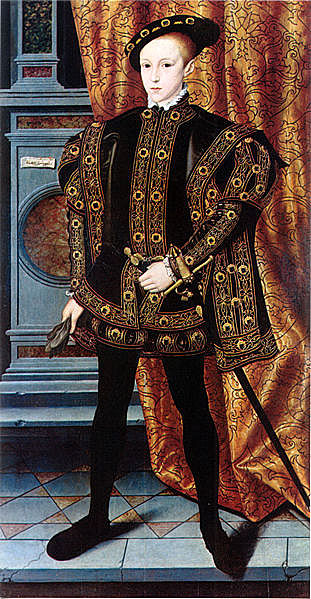 c.1550 aged 13 by William Scrots
King Henry VIII's Last Will dated December 30th, 1546 where he appointed 16 executors to carry out government & care for his son King Edward VI.
|
| Edward with his father and mother, Jane Seymour, who had died long before this picture was painted | The Death of King Henry VIII (January 28th, 1547)Edward VI and the Pope: An Allegory of the Reformation. This anonymous work of propaganda depicts the handing over of power from Henry VIII, who lies dying in bed, to Edward VI, seated beneath a cloth of state with a slumping pope at his feet. In the top right of the picture is an image of men pulling down and smashing idols. At Edward's side are his uncle the Lord Protector Edward Seymour, and members of the Privy Council. |
(thereafter Duke of Somerset) & First Lord Protector
John Dudley, Duke of Northumberland 2nd Lord Protector |
January 31st, 1547 - The Executors decided
and as of this date the 16 executors were :
| - Thomas Cranmer, Archbishop of Canterbury | | - Edward Seymour, Earl of Herford (thereafter Duke of Somerset) | | - John Russell (thereafter Baron Russell, Earl of Bedford) | | - John Dudley, Viscount Lisle (thereafter Earl of Warwick, Duke of Northumberland) | | - Sir Anthony Denny | | - Sir William Herbert (thereafter Earl of Pembroke) | | - Thomas Wriothesley - pronounced Risley(thereafter Earl of Southampton) | | - Cuthbert Tunstall, Bishop of Durham | | - Sir Anthony Browne ("the elder") | | - Sir Edward Wotton | | - Dr. Nicholas Wotton, Dean of Canterbury & York | | - William Paulet, Baron St. John of Basing (thereafter Earl of Wiltshire, Marquis of Winchester) | | - Sir William Paget (thereafter Baron Paget) | | - Sir Edward North | | - Sir Edward Montague, Chief Justice of the Common Pleas | | - Sir Thomas Bromley, Chief Justice of the King's Bench |
|
| Coronation of Edward VI, stained glass, Mansion House, London. | |
LITERATURE:
Non-Fiction
- England's Boy King: The Diary of Edward VI, 1547-1553. Edited by Jonathan North. Welwyn Garden City: Ravenhall Books, 2005.*
- Hester W. Chapman The Last Tudor King (1958),
-
Sir Clements R. Markham, King Edward VI: An Appreciation (1907). -
-
G. Dickens, The English Reformation (1964; rev. ed. 1967). -
Hayward, John, Sir, The life and raigne of King Edward the Sixth, Kent, Ohio: Kent State University Press, 1993 (originally published in 1630). -
A. F. Pollard, England under Protector Somerset (1900) Political History of England, 1547–1603 (1910) -
J. D. Mackie, The Earlier Tudors, 1485–1558 (1952, 2d ed. 1959); studies by W. K. Jordan (1968 and 1970). -
Edward VI, King of England. Chronicle and Political Papers of King Edward VI. Edited by W. K. Jordan 1966. -
Jordan, W. K. Edward VI: The Threshold of Power, The Dominance of the Duke of Northumberland. London, 1970. & Edward VI: The Young King, The Protectorship of the Duke of Somerset. London, 1968. -
Loach, Jennifer. Edward VI. Edited by George Bernard and Penry Williams. New Haven and London, 1999. -
Mac Culloch, Diarmaid. Tudor Church Militant: Edward VI and the Protestant Reformation. London, 1999. -
Chris Skidmore, Edward VI: The Lost King of England 2007 -
David Williamson, Kings and Queens of England 1998
Fiction
|
|
